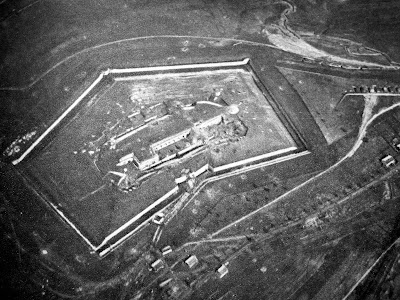 |
| Villages mentioned in this post - top/centre (click to enlarge) |
Samogneux was one of the small villages strung out along the hills, forests and valleys on the eastern bank of the River Meuse.
In February 1916, Samogneux, Brabant, Beaumont and Forges became key points for those French soldiers escaping the slaughter in the forests to the north. They also became targets for the German artillery gunners who continued to use planes and balloons to target the retreating French forces.
 |
| Brabant sur Meuse before 1916 |
Brabant had been evacuated early in the third day. Three hours later, a message was delivered to the front line stating that the previous order had been a misunderstanding. Brabant should be reoccupied as a matter of some urgency with the added order that 'not too many men be used in the operation'.
Not for the last time, the lack of understanding between front line forces and distant commanders was obvious. There were no French soldiers capable of regaining the village and German forces easily took the strategically important position.
The third day ground on in a flurry of order and counter order. There were some successful French counter attacks but communication and any sense of coordinated strategy resulted in growing disorder and confusion.
 |
| Beaumont before 1916 |
 |
| Beaumont - late February 1916 |
The village of Beaumont occupied a slight rise of higher ground and was now occupied by a number of French platoons who had been drawn towards it at the end of the first day of battle. This had been the destination of Driant's attempted escape from the Bois des Caures.
German attempts to take the village were costly - a 'day of horror' according to the official German history of the battle. Machine gunners hidden in the cellars and houses of Beaumont took a heavy toll of the advancing German Hessians. Only the destruction of the buildings on top of the French defenders finally allowed the Germans to take the village; at huge cost.
It was the German experience of attempts to take villages such as Beaumont that gave the Germans a false sense of the scale of the defence that faced them and that went some way in checking their advance during the first days of the battle.
The focus of the battle hinged around the village of Samogneux by the late afternoon and illustrates once again the utter confusion of the French defenders.
Survivors from the Bois des Caures and the other forest redoubts to the north had started to flow away from the frontline back towards the city of Verdun itself. At some point in the chaos it was reported that Samogneux had fallen to the Germans. This message was relayed back down the line and the order was given to recapture the position.
 |
| German troops in Samogneux - February 1916 |
 |
| Samogneux - before the battle |
At 10:00pm the French artillery set their coordinates on Samogneux and the bombardment begin. This was a ghastly mistake. Samogneux had in fact not fallen to the Germans, it was being held by a small number of French defenders.
Realising that they were under fire from their own side the French in Samogneux sent up a series of green flares, the pre-arranged signal of 'cease fire'. The flares were ignored.
By 3:00am the defence of Samogneux was over and the Germans had quickly taken advantage of the situation.
Samogneux also registered the end of an entire French military division - the 72nd. It had lost almost 10,000 soldiers and almost all the officers.
*
In the freezing cold night at the end of the third day of the battle it is apparent now that the German high command underestimated the position they were in. The brave defence in pockets along the hills to the east of the city gave a false impression of the French position. By the fourth day of the battle, the Germans were actually closer to victory at Verdun than they could have imagined.
The villages today
To the modern day visitor to Verdun the villages along the left bank of the Meuse offer some of the most spectral reminders of the battle.
This Reuters site offers very good before/after images.
I will produce a special 'ghost village' post later in this blog.




























